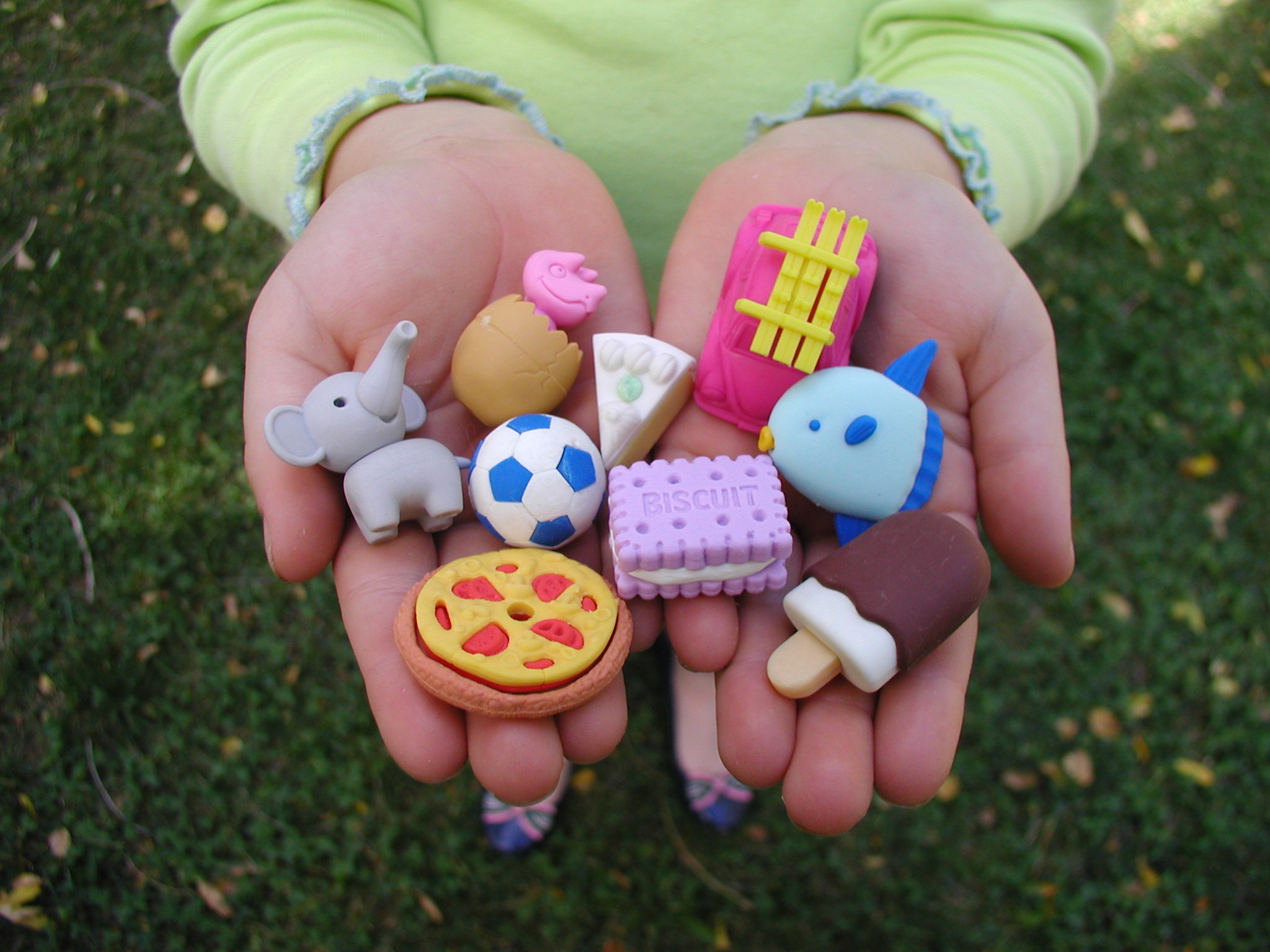 A while back Todd took our daughter Annie (8) to the nearby hardware store. This locally-owned place is stocked with just about every basic item you could want. Todd needed drywall anchors and screws. Annie asked to stay by the Japanese eraser display while her dad went to find the fasteners section.
A while back Todd took our daughter Annie (8) to the nearby hardware store. This locally-owned place is stocked with just about every basic item you could want. Todd needed drywall anchors and screws. Annie asked to stay by the Japanese eraser display while her dad went to find the fasteners section.
I can’t recall when the first Japanese eraser toy made its way into our home. I think it was probably given to Annie as a party favor. I’d never seen one. Basically they’re small toys made of soft rubbery material, so your kids can add the phrase “and they’re erasers!” to their purchasing pleas. They come in numerous forms, from farm animals to random food products such as Japanese cans of soda pop, unappetizing, British cookies labeled biscuits, or strawberries colored yellow, pink, and red. If you’re a sports fan, there are colorful balls, bats, and mitts. Each tiny eraser is actually several puzzle pieces fit together, able to be dis- and reassembled.
On the day of the store run, Annie owned maybe five of these toys. As she stood admiring the prolific display of erasers, a salesperson handed her “The Japanese Eraser Official Guidebook”. Annie returned home ecstatic. “Look what this lady gave me for free!” You guessed it – Annie’s prized possession was basically a catalog of Japanese erasers. The thing was eight pages long and must have included 500 different erasers. As Annie excitedly showed me the next ten erasers she hoped to buy, I noticed the catalog also offered two handgun erasers. Note to Japanese Eraser Company: Hello Kitty wasn’t armed and she sold just fine.
Annie poured over her catalog and later brought it to our local playground where we met our neighbor Dana and her daughter, Sophie. Sophie was only five, but seemed already to know how cool and life-altering these Japanese erasers were. Now she and Annie were both scanning the pages with focused intensity. Soon Sophie too carried a list of the ten erasers she wanted most. I’m so sorry Dana!
The salesperson had given Annie the Japanese eraser catalog and hooked her in. Then Annie reeled in Sophie. Ah, modern marketing. As I’ve read more about how corporations are marketing to children these days, I’ve discovered one of the methods they use most is having kids convince other kids to buy their products, just as I’d watched Annie do with Sophie. As children get older, more stealthy tactics are used. Certain kids are offered a free trial of a new product, “before your friends have seen it!” Those lucky few strut around school with the new item, and as is the way of the schoolyard, soon everyone wants one.
I guess I pretty much knew that big business marketing campaigns were behind Americans’ increasing consumerism. I buy therefore I am. And I was also aware that the secret weapon of advertising is the message that we lack something and won’t feel complete until we buy what we’re missing. Now that I have kids, though, I hate that mass media tells them they are lacking in some way. Won’t they get that message daily in middle school? It’s awful that advertising takes advantage of kids’ more fragile self-images, telling them there’s something wrong with them when five minutes before they were sitting on the sofa feeling fine.
As I’ve learned more about the tools marketers use today, I’ve been most saddened by this background message suggesting we are incomplete. I want my kids to embody the attitude of “I am enough” and “I have enough”. Instead the sneaky ads tap them on the shoulder and whisper, “Remember, you are what you wear.” “Everyone notices what kind of school supplies you have.” “You’re only as good as what you own.”
While reading Tips for Parenting in a Commercial Culture from Center for a New American Dream, I came across a concept about which I was previously unaware. The booklet (which you can download free) pointed out that another major marketing message is: Life should always be easy, and there’s something wrong if it isn’t. The ads then suggest you buy their product or pill when you struggle with something, and magically everything will improve. I know this view is prevalent in Western culture these days, but I guess I thought it evolved on its own, not in some secret marketing meeting.
The “life should be easy” mindset is one I regularly challenge in my kids. “Why would you think everything would be easy? You should be proud of yourself for working hard to master something. People become best at what they practice most.” In this blog I’ve written about teaching my kids how to fail (well), and encouraging persistence in my kids. So, when I realized corporate media campaigns are working at cross-purposes with my parenting focus, I was initially shocked, then angry.
Looking for ways to combat the ever-present media messages in my kids’ lives, I read Living Simply with Children, by Marie Sherlock. I learned what I’d known intuitively, that advertisers purposely separate children from their parents then aim their messages at the kids one-on-one. The same businesses who declare family-friendliness are finding ways to influence our kids outside our earshot. At our house, this direct-to-kid advertising has been happening over the computer. However, it’s harder than you’d think to fight it.
As the experts advise, we’ve placed our computer in a central location. You practically trip over it when passing by. Our son Daniel (11) is allowed to play online educational games with our permission. Of course, he always asks at chaotic times. Do they do this consciously? It’s truly a skill. So, I’ll quickly assess the game he’s about to play (usually one a school friend has shown him). The games tend to look fairly harmless, even a little boring. I give Daniel my consent and return to the four other things I’m juggling. I now realize that these online educational games have numerous ads intertwined within them, often only popping up toward the end of play. We don’t have cable television so Daniel doesn’t see many commercials, but it turns out he’s been receiving his dose of ads online under the guise of learning games.
Five Actions to Help Immunize Our Kids Against Advertising:
1. Reduce TV time.
According to numerous sources, the most significant action we can take to reduce our kids’ exposure to advertising is setting limits on television watching.
2. Read books about how marketing works with your kids.
A book titled Made You Look: How Advertising Works and Why You Should Know, by Shari Graydon explains various secrets of advertising to older kids and teens. It touches on numerous marketing techniques from airbrushing magazine photos to product placement on film and TV, to Internet advertising.
3. Play games to deconstruct commercials.
My friend Margaret has her five and eight year-old kids mute the TV during commercials and try to guess the product being sold. She says her kids really enjoy this game. Margaret notes that muting the commercial allows one to pay closer attention to certain details such as the body language and emotions actors use to sell a product. Made You Look additionally suggests leaving the TV’s audio on and but turning away from the screen as a means of understanding a commercial’s use of language, music, pace, and sound.
4. Listen to the message underneath your child’s nagging and pleading.
In Living Simply with Children, Marie Sherlock reminds parents to listen to the messages beneath kids’ nagging for material things. If you can keep your child talking, they may eventually express their underlying emotions. Perhaps they feel left out of an opportunity. Or maybe asking for certain things is a way of saying they think they don’t fit in at school. Although we parents still might not spring for the wanted item, our kids will feel heard by us. With your help your child can devise additional ways to face his or her challenges.
5. Share your own struggles with “wanting” with your child.
We parents are just as susceptible to keeping up with the Joneses as our children are to wanting what the Joneses’ kids have. We might tell our kids how we handle our wants, on good as well as bad days. We can also admit to things we’ve bought and later regretted, or share childhood stories of how badly we wanted that Barbie camping van, or the shoes all the cool kids wore.
It’s been three months since Annie got the Japanese eraser catalog, and although she hasn’t bought any new erasers for a while, I still can’t extract this treasured item from her room without fierce opposition. However, she will play the guessing game about commercials my friend Margaret uses.
I’ll close with an upbeat statistic:
The Center for a New American Dream did a study which found that of 9-14 year-olds, 57% would rather do something fun with their parents than go shopping.
More ideas for teaching kids about advertising? Leave a comment below!

 Sweet Spots: Helping Your Kids Find ENOUGH in Their Lives.
Sweet Spots: Helping Your Kids Find ENOUGH in Their Lives.


Very thoughtful analysis, engagingly written, with smart, concrete suggestions. I’m honored to have Made You Look referenced on your valuable blog, which I’ll share with parents I know.
Shari Graydon
Thanks so much! I’m glad you liked it.